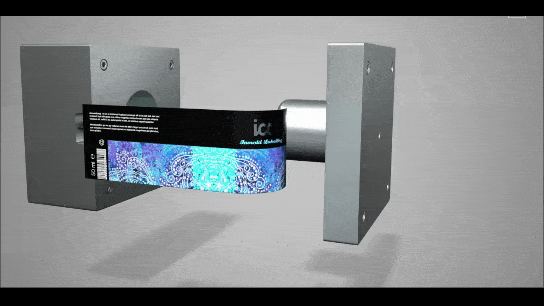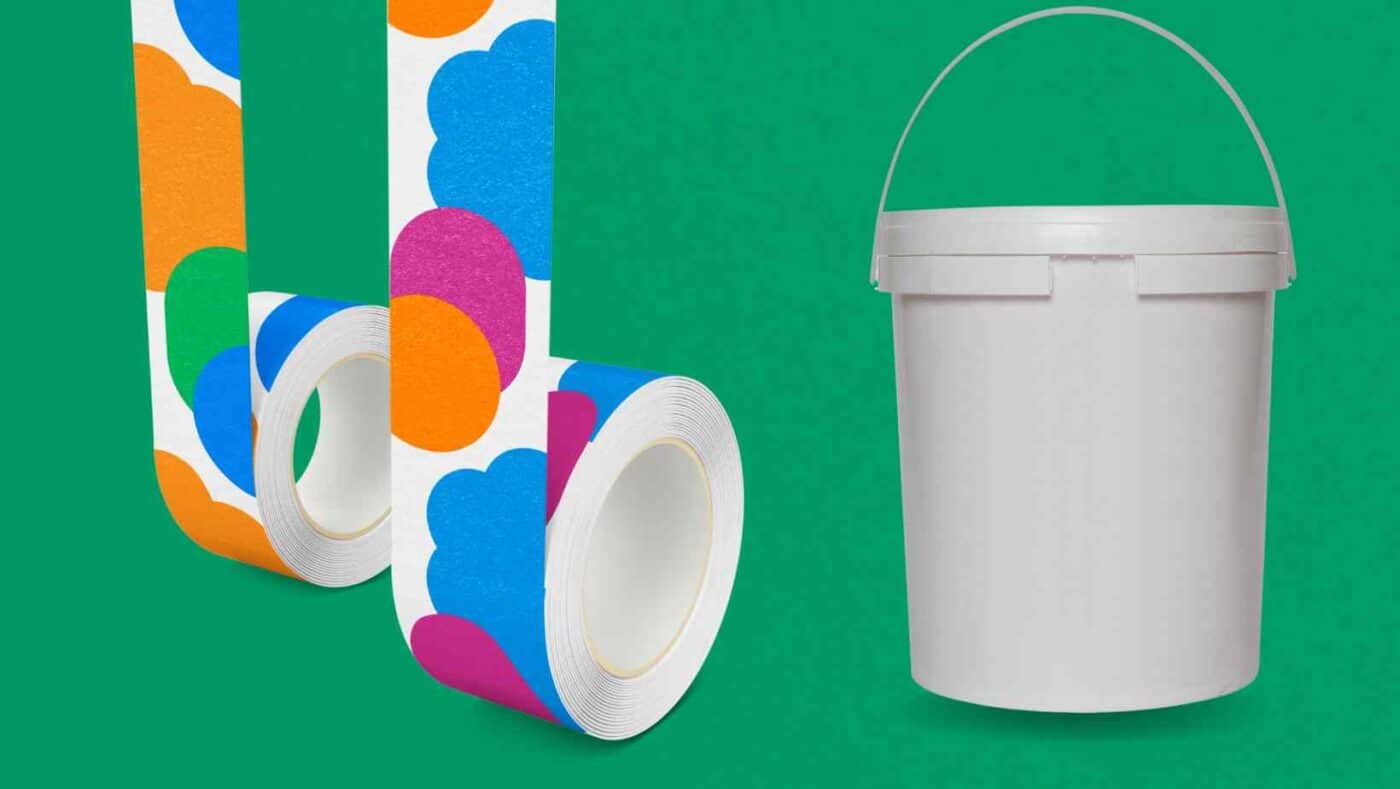Are you in the packaging industry and looking for ways to enhance your product’s visual appeal? One popular solution is adding printed designs onto buckets and containers. There are two primary methods for printing designs on packaging: Full Wrap Printing and In-Mold Labeling (IML). While both methods achieve a visually appealing result, there are differences between them.
Table of Contents
What is different Full Wrap and IML?
Full wrap printing involves printing the design onto a film that fully covers the container’s surface. The film is then heat-sealed onto the container, creating a seamless and visually striking appearance. This technique allows for full coverage of the packaging’s surface, providing ample space for creative designs and branding.
In contrast, IML printing involves placing a label with the design onto the packaging during the molding process. The label becomes an integral part of the containers, making it durable and resistant to wear and tear. The IML method provides a superior level of accuracy and precision in design placement, which is particularly important when using small or intricate designs.

More About for IML
What is IML?
So, how do you decide which option is best for your product? It depends on your priorities.
Advantages of Full Wrap Printed Bucket
Full Wrap Printed packaging are an excellent marketing tool that can help businesses stand out in a crowded marketplace. These custom printed buckets offer numerous advantages over traditional marketing methods, making them a popular choice for businesses of all sizes. In this article, we will explore the advantages of full wrap printed buckets and how they can help your business grow.
Firstly, full wrap printed containers provide extensive branding opportunities. The customized design possibilities are limitless, allowing businesses to create a unique marketing tool that reflects their brand identity. Full wrap printing ensures that the packaging is completely covered with the design, resulting in maximum visibility for your brand.
Secondly, these containers are durable and long-lasting, making them ideal for outdoor events or expos. They are made from high-quality materials that are resistant to wear and tear, ensuring that your message remains visible even after extended use. This durability also makes them an eco-friendly option as they can be reused multiple times, reducing waste.
Thirdly, full wrap are cost-effective marketing tools. Unlike other forms of advertising such as billboards or television ads, the cost of designing and producing a full wrap printed bucket is relatively low. This means that businesses can reach a large audience without breaking the bank.
Fourthly, these products offer versatility in their usage. They can be used for a variety of purposes – from holding drinks at events to storing tools on construction sites. This versatility makes them an attractive marketing tool for businesses across different industries.
Advantages of IML Printed Packaging
When it comes to packaging solutions, there are a variety of options available in the market. One option that is gaining popularity is IML printed buckets. In-mold labeling (IML) is a process where a pre-printed label is placed inside a mold and then melted into the plastic container during the manufacturing process. In this article, we will discuss the advantages of using IML printed packaging.
Firstly, IML printed containers offer excellent branding opportunities. The labels used in IML printing are of high quality and contain vibrant colors. This means that the branding message on the label can be eye-catching and stand out from competitors. Additionally, the labels are durable and resistant to wear and tear, ensuring that the branding message remains intact throughout the product’s lifespan.
Secondly, IML printed products are highly customizable. The labels can be printed with a variety of designs, patterns, and colors to suit different product types and customer preferences. This means that businesses have the flexibility to create unique and attractive packaging for their products.
Thirdly, IML printed buckets are eco-friendly. The use of plastic containers has been a concern for environmentalists. However, IML printing can be made from recyclable materials, making them an environmentally friendly option. Furthermore, the in-mold labeling process eliminates the need for additional labels or stickers, reducing waste.
Fourthly, IML printed buckets offer superior quality. The labels used in IML printing are of high quality and are fused with the container during the manufacturing process. This means that the label is less likely to peel off or fade over time, ensuring that the packaging remains visually appealing.
Finally, IML printed buckets offer cost savings. While the initial investment in IML printing technology may be higher than traditional labeling methods, the long-term benefits more than make up for it. IML printed buckets have a longer shelf life, reduced waste, and improved durability, resulting in cost savings over time.
In conclusion, IML printed buckets offer an array of advantages, including excellent branding opportunities, high customizability, eco-friendliness, superior quality, and cost savings. As more businesses look for sustainable packaging solutions, IML printed buckets are becoming an increasingly popular choice.
To Learn More About Why You Should Choose Printed Buckets:
Why Choose Custom Printed Buckets
Disadvantages of Full Wrap Printed Packaging
When it comes to promoting a brand or product, businesses often turn to advertising techniques that are highly visible and striking. One such method is the use of full wrap printed buckets, which can be used for a variety of purposes ranging from holding popcorn at movie theaters to serving drinks at music festivals.
However, while these products may seem like an attractive advertising opportunity, there are several disadvantages that businesses should consider before investing in them.
Firstly, full wrap printed buckets can be expensive to produce. The cost of printing graphics and text onto the bucket’s surface can quickly add up, especially if the business wants to create a custom design that stands out from the competition.
Secondly, the production process for these buckets can be time-consuming. In order to achieve high-quality print results, the buckets must be made from a specific material that can withstand the printing process without becoming damaged or distorted. This means that businesses may need to wait for extended periods of time before their custom-designed buckets are ready for use.
Another disadvantage of full wrap printed buckets is that they may not be environmentally friendly. Many of these buckets are made from plastic, which can take hundreds of years to decompose, leading to a negative impact on the environment.
Furthermore, although these packaging may be eye-catching and attractive, they may not always be practical or convenient for consumers. For example, large, bulky buckets may be difficult to carry around at events or may take up too much space in a customer’s bag or purse.
In conclusion, while full wrap printed buckets can be effective advertising tools, businesses should weigh the disadvantages against the benefits before investing in them. These drawbacks include high costs, long production times, negative environmental impacts, and impracticality for consumers. By carefully considering these factors, businesses can make an informed decision about whether or not to use full wrap printed buckets as part of their marketing strategy.
Disadvantages of IML Printing Packaging
IML or In-mold labeling is a popular technique used in printing that involves fusing a label directly into the plastic container during molding. This process has been widely adopted in the packaging industry due to its many benefits, including durability and cost-effectiveness. However, as with any technology, there are some disadvantages of IML printed containers that need to be taken into consideration.
One significant disadvantage of IML printed buckets is that they are not suitable for all types of products. For instance, if the product inside the packaging requires high-temperature storage, then IML labeling may not be an ideal choice. The reason is that the heat involved in the product’s storage can cause the label to peel off, resulting in reduced product appeal and even loss of branding. Therefore, manufacturers need to consider the storage requirements of their products before opting for IML printing.
Another limitation of IML printed food containers is that they come with a high initial investment cost. The process of setting up IML printing machines and creating molds for printing can be expensive, making it challenging for small businesses to adopt this technology. Additionally, the process of changing labels for different products can also be time-consuming and costly.
Furthermore, IML printed products have a limited design flexibility compared to other printing methods such as direct printing. Since the label is fused directly onto the bucket during molding, any changes in design require new molds to be made, which can result in extended downtime and increased costs.
Lastly, the recycling process of IML printed buckets can be complicated. Separating the plastic container from the label during the recycling process can be challenging, which can lead to a reduction in the recycled material’s quality.

